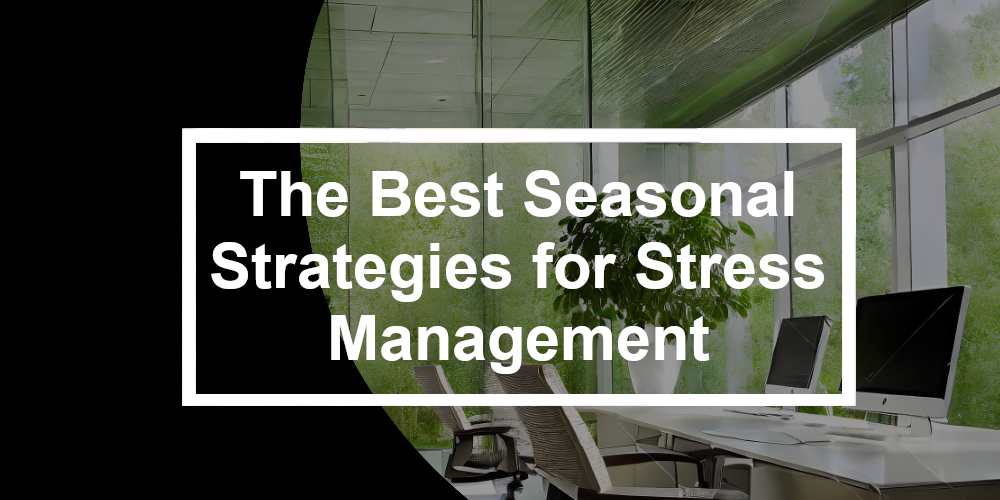
As the seasons change, so do our work environments and personal routines, bringing with them a unique set of challenges and stressors. Whether it’s the shift to colder, darker days in winter or the transition to the bustling activities of summer, these changes can significantly affect our mood, energy levels, and overall well-being. Recognising and adapting to these seasonal shifts is crucial for maintaining a healthy work-life balance and managing stress effectively. This article explores various techniques and tips designed to help you navigate the complexities of seasonal changes, ensuring you stay productive, balanced, and mentally healthy throughout the year.
Recognise Seasonal Impact on Stress

Awareness:
Acknowledge how changes in seasons affect your mood and energy. For example, winter’s reduced daylight might contribute to a decrease in energy, known as Seasonal Affective Disorder (SAD) for some, affecting productivity and stress levels.
Adaptation:
Making intentional adjustments to your routines to better accommodate these changes can help. For example, in winter, find ways to introduce more light into your life, and in summer, take advantage of the longer days to engage in outdoor activities after work.
Create a Comfortable Work Environment

Lighting:
Use bright, warm lights in colder months to combat the lack of sunlight, and during sunny seasons, position your workspace to benefit from as much natural light as possible without causing glare.
Temperature Control:
Use personal comfort devices like fans, heaters, or humidifiers to create an optimal working environment, especially if you’re working from a home office where you have more control.
Nature and Plants:
Adding greenery to your workspace or setting up near a window with a view can help reduce stress and increase feelings of well-being, leveraging the biophilic design principle.
Maintain a Regular Routine
Sleep Schedule:
Consistent sleep and wake times help regulate your internal clock, which can be particularly beneficial during seasonal transitions when daylight hours change.
Work Hours:
Establishing and sticking to set work hours, even if they’re adjusted seasonally, can help manage stress by maintaining a sense of normalcy and expectation.
Incorporate Physical Activity

Seasonal Activities:
Tailor your physical activity to the season—such as swimming in the summer or skiing in the winter—to stay active and engaged with the changing environment.
Regular Exercise:
Consistent physical activity, regardless of the type, can significantly reduce stress levels, improve mental health, and enhance sleep quality.
Adopt Stress-Reduction Techniques
Mindfulness and Meditation:
Engaging in regular mindfulness practices or meditation can help centre your thoughts, reduce anxiety, and manage stress, providing a mental break from work and seasonal worries.
Deep Breathing:
Implementing deep breathing techniques, such as the 4-7-8 method, can quickly reduce stress levels and is an easily accessible tool that can be used anytime, anywhere.
Set Realistic Goals and Priorities

Adjust Expectations:
Recognise that productivity might fluctuate with the seasons and set achievable goals that reflect what’s realistic for you during these times, thereby reducing unnecessary stress.
Prioritise Tasks:
Concentrating on the most critical tasks during your peak energy times of the day ensures you’re making the most of your productive periods, helping manage workload and stress better.
Seek Social Support

Connect with Others:
Engaging with friends, family, or coworkers can provide emotional support, offer different perspectives on stressful situations, and decrease feelings of isolation, especially important during extreme seasons.
Professional Help:
If seasonal changes severely impact your mental health, reaching out to a therapist or counsellor can provide strategies to cope more effectively, ensuring stress is managed in a healthy way.
Embrace Flexibility
Adapt Work Schedules:
Being open to modifying your work schedule, such as starting earlier or later, can help you take advantage of the most productive times of your day according to the season.
Take Breaks:
Regularly scheduled breaks, even brief ones, can significantly reduce stress by allowing your brain to reset, increasing productivity and focus when you return to work tasks.
By acknowledging the impact of seasonal changes and implementing these strategies, individuals can better manage stress, maintaining a healthy balance between work and personal life throughout the year.
Adapting to the changing seasons requires a blend of self-awareness, flexibility, and proactive planning. By implementing these strategies, you can better manage stress and maintain a healthy balance between your professional and personal life, regardless of the time of year. As we navigate through the seasons, it’s important to remember that our well-being should always remain a top priority. By taking steps to adjust our routines, work environments, and self-care practices, we can ensure that we stay resilient, productive, and balanced throughout all the seasonal changes life throws our way. Additionally, if you’re looking to make a career move or seek new opportunities as part of your personal growth and adaptation strategy, don’t hesitate to upload your CV or complete our digital registration form. Take the first step towards your next career milestone and search for jobs on our platform to discover how the right role can further enhance your work-life balance and overall well-being.